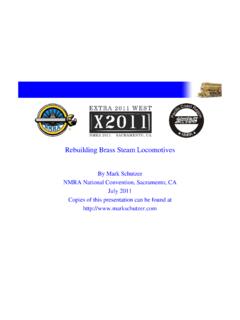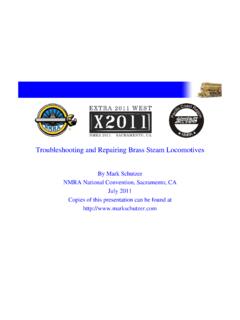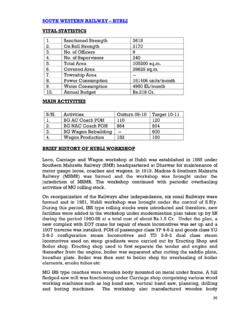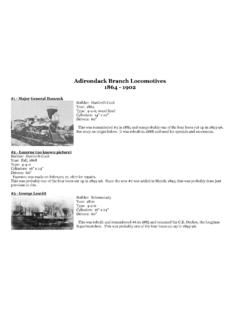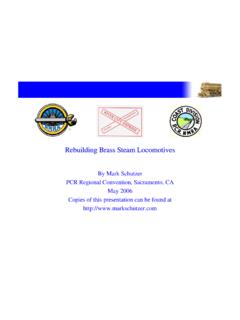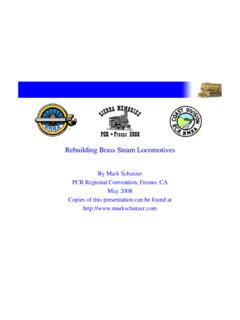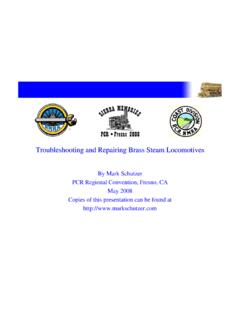Transcription of Hornby Black Five detailing - Brassmasters
1 Hornby Black Five detailing /upgrade kitHornby s DCC-ready Black Five is a good model that, with a little effort, can be transformed intoan excellent one. The principal areas needing attention are the front frames and cylinders, therear end under the cab, the coal space and the tender axleboxes. This kit provides a range ofdetailing components that will significantly enhance your Hornby model and enable you toproduce an accurate portrayal of an individual locomotive. As you will see from the prototypenotes below, there were many detail differences among the Black Fives and indeed Hornbythemselves produce several boiler and tender variants. Make sure you have the right versionbefore (intentionally or otherwise) you start rebuilding it into something detail parts will make a big difference to the appearance of the loco. But even if you retainHornby s 00 gauge driving wheels, the model will look a lot better if you replace the bogie andtender wheels with the correct Stanier bevel-rim pattern, available from Alan Gibson or SharmanWheels.
2 You may also consider replacing the over-scale handrail knobs. Tim Shackleton s reviewof the Hornby Black Five in issue 138 ofModel Railway Journalsuggests other improvementsyou can makeclose-coupling the loco and tender, for instance, and thinning down the exposededges of the tender any RTR upgrading exercise, however, there s a limit to how far you can go before buildingfrom a kit starts to seem like a more sensible optionespecially if you model in EM or P4. Theperfectionist might well look at Hornby s Black Five and think about building a compensatedchassis for it, or replacing the valve gear, or adding a fully riveted footplate. All theseimprovements are possible, but fall beyond the scope of this kit. So if this is the level of prototypefidelity you aspire to, we might just mention that Brassmasters already do a true finescale kit forthe Black Five, from which most of the components in this detailing pack are derived..Prototype notesFor a supposedly standardised class, there were an amazing number of variations among theBlack Fives- and that s without considering the Caprotti locomotives and the unique Stephensonlink engine.
3 Moreover, engines built with oneparticular set of features often acquired differentcharacteristics during works visits. If you are thinking of renumbering or modifying the Hornbymodel, we have listed the main points to be aware of. We have used LMS numbering throughout,except when referring to the 100 BR-built engines that were never in LMS 44658-767 had a longer wheelbase (27ft 6in rather than 27ft 2in).BoilerNos 5000-224 were built with short fireboxes, while the rest of the class had a twenty-year period around 30 short-firebox engines (including Nos5002/7/8/11/20/22/3/6/7/40/5/7/9/54/7 -9/66/82/7/8/97/108/9/24/42/51/63/9/77/9 7) are known tohave received the long-firebox pattern during heavy general repairsafter modification,they werevirtually identical to Nos 5225-499 and 4800-96, although a handful later reverted to short-fireboxboilers. At least three long-firebox engines (Nos 45433/43/61) were subsequently rebuilt withshort-firebox boilers.
4 Long-wheelbase engines Nos 44658-767 had long-firebox boilers with a 4inlonger smokeboxthe easiest way to identify them is by the teardrop-shaped cover of the 28-element superheater on the smokebox being below the handrails, and the forward-mounted topfeed. Note that, in time, some standard-wheelbase Black Fives with central top feed acquired thistype of (or lack of)andtop feedNos 5000-74 were built with domeless boilerswhat appears tobe a dome on the centre boiler ring is actually the cover for thetop feed. On 5020-69 the pipesto this top feed were prominent but on the others they were flush with the boiler cladding; Nos5020-69 were quickly modified to conform with this style. A handful of domeless-boiler engines,usually but not exclusively fromthe Scottish Region, had a conventional top feed rather than thedome-shaped version. Most of the short-firebox, domeless-boiler engines were later rebuilt with asteam dome on the rear boiler ring and a top feed in a separate housing on the centre ring, wherethe dome used to be.
5 Boilers were routinely exchanged during works visits and the domelessboilers moved freely around between short-firebox engines Nos 5000-224; as far as we can trace,only around 35 locomotives seem never to have carried a domedboiler. All long-firebox engineshad the steam dome on the rear boiler ring but, as built, the top feed could be either on the centrering (Nos 5225-5499 and 4800-4996) or on the front boiler ring (all long-wheelbase Black Fivesplus 4768-4799). There wasmuch swapping of boilers over the lifetime of these engines, andmany interesting anomalies,for instance, in BR days short-firebox engines Nos 45011/82/7receivedlong-firebox boilers with forward top feed. As always, look for visual confirmation ofthese features before choosing a number for your beamsthese were plain on 5000-499 (apart from two prominent bolts on the outer ends).Engines numbered below 5000 had riveted bufferbeams but following accident damage, somelocomotives from the original series also acquired this pattern.
6 All tender buffer beams, however,were riveted. Many locomotivesespecially those allocated to Scottish shedshad two lines ofvertical holes drilled into the buffer beams for use with snowplough steam-heat pipesNos 5020-69 and 5075-224 did not have these when built, althoughsome later gained them. Note that the flexible pipe was often removed during the summermonths, although the valve remained in chimneysNos 5020-69 atfirst had taller chimneys than those fitted to the rest of the class,but by Nationalisation all had the standard weights- short-firebox engines originally had plain balance weights, while those onlong-firebox engines were rodsNos 5000-5471 were built with plain, fishbelly-section coupling rods. Nos 5472-99 and 44658-999 had the fluted pumpsin pre-war years many engines had a pump driven off the left-hand were removed in the late windowsboth the cab side windows on Nos 5000-499 could be opened. The forwardwindow was mounted in a sliding frame.
7 On later engines the forward window was fixed, theframe was omitted and the beading was changed from half-round with radiused bottom corners toflat with square bottom four Black Fives (Nos 5154/6-8) carried names, although there have long beenrumours that No 5155 was namedQueen s Highlander(sometimes quoted asQueen sEdinburgh) between 1942 and1944. The nameplates, with crests, were carried on a flat platemounted over the centre driving BR days many locomotives were fitted with a Smith Stone s speedometer,driven off the left-hand rear fittingsby the late 1950s many engines had acquired BR-pattern AWS equipment, withsmall cylinders mounted on the footplate ahead of the cab and a bang plate below the bufferbeam to protect the bogie-mounted receiver. The wiring was carried in a conduit running alongthe left-hand footplate Black Fives ran with three types of tender. As built, Nos 5000-124 had rivetedtenders, while 5225-499 and 4800-6 had welded tenders and the remainder had part-welded/part-riveted tenders.
8 Some ran with the sametender all their lives, but many swappedwith other types. Tender spring hangers could be either long or short. Part-welded tenders hadrectangular vents instead of the usual mushroom pattern and some had roller-bearing LMS built four self-weighing tenders for test purposes which, at different times, wereattached to various Black notes are for your guidance onlyas always, check with dated photographs to see howyour chosen loco looked at any given time. Almost any railway book or magazine published in thelast sixty-odd years will contain at least one photograph of a Black Five but we can recommendthe following sources of pictorial reference material:J S Whiteley and G W MorrisonThe Power of the Black Fives(OPC, 1988)R J Essery and D JenkinsonIllustrated History of LMS Locomotives, volume 5( Silver Link, 1989)A J PowellStanier Locomotive Classes(Ian Allan, 1991)Locomotive IllustratedNo 6 (Ian Allan, 1976)Model Railway JournalNo 25 (1988)British Railway JournalNo 21 (1988)Assembly hintsAll parts in this kit can be fitted to the Hornby model using a two-part epoxy resin adhesive, suchas Loctite Super Steel or Araldite Rapid.
9 Use a spot of gel-type superglue for small soldering is required,although you may prefer to solder the coping strip to the tenderbulkhead. We assume you will be using photographs or scale drawings to confirm the location ofparts, so no specific measurements have been lines are marked on the rear of the etch, as are the dimples for forming rivets on parts 4, 6,11 and 14. If you don t have a riveting tool, lay the component face down on a flat piece of lead orhard rubber and gently impress the rivet with the point of a pair of dividers or parts from the etched fret by laying it face down on a smooth, hard surface (such as asheet of perspex or hardboard) and cutting through the tabs with a sharp craft knife or Stanleyblade. Carefully file off the tabs, avoiding buckling the components. You may prefer to prime andpaint them before attaching them to the model, which will make life easier (you could even spraythe whole fret Black before starting work).
10 Pointed tweezers are the best tool to use for handlingsmall parts. A number of spares have been includedwe know what happens to tiny components..The castings may need a little cleaning-up to get rid of moulding flash. Emery-board nail files arefine for this, then finish off with fine wet and dry. Again, they can be painted before car paint (satin Black or matt Black ) is easy to usejust put the parts to be painted in ajam-jar lid and spray from about nine inches away. When dry, turn them over and spray any modelling isn t as inherently dangerous as snowboarding or bungee-jumping but it stillhas its hazards. Be careful when using sharp tools, always follow manufacturers safety hintswhen handling adhesives and wear eye protection when working with power tools. Remember toothat modifying your Hornby model in any significant way will almost certainly invalidate themanufacturer s guarantee. To preserve your rights, check it over mechanically and electricallyand ensure it is well run-in before adding any detail listEtched fret1a frame extensions and motion bracket, left1b frame extensions and motion bracket, right2 plain angle iron strip3 riveted angle iron strip4 front bulkhead overlay5 buffer steps (6)6 tender lifting lugs and base (2)7 tender rear steps8 lamp brackets including two for front bulkhead9 coping strip for bulkhead10 riveted front buffer beam11 AWS bang plate12 frame for dummy sliding window13 reinforcing rings for front lifting point14 front cylinder covers15 tender rear guard ironsCastings16 axle boxes (6)17 springs(6)18 whistle19 safety valves(2)20 speedometer21 AWS cylinders large and small22 relief valves (2)23 drain cocks (2)24 steam heat and vacuum pipes (loco and tender)25gravity lubricators(2)

